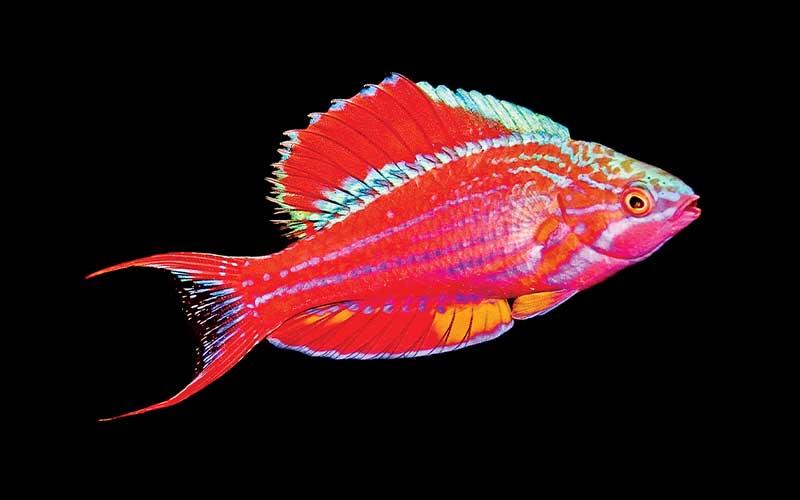Charles Darwin, bundled in a frock coat and bowler hat against a freshening English chill, trudged along a sand path deep in thought. It is 1860, less than a year since the publication of On the Origin of Species, and his mind reeled with a particularly troubling question he barely touched in his controversial text: Why do the males of certain species develop extravagant visual traits? Such obvious encumbrances to survival seem to fly in the face of natural selection, the revolutionary idea he so recently unfurled to the world. That morning he had poured out his frustration on the subject in a letter to the American botanist Asa Gray: “The sight of a feather in a peacock’s tail, whenever I gaze at it, makes me sick!”
More than 150 years later and 50 feet below the surface, the question, still the subject of debate, percolates through my mind as I watch a dazzling example of sexual selection unfold in a fast-action theater of fanciful fins. The gaudy, oversized regalia belong to impassioned male flasher wrasses showcasing their genetic superiority in a late-afternoon spawning ritual. The show is simply stunning.

Anna and I have fallen in love with many fishes during our lives, but none has seduced us quite like flasher wrasses — the underwater world’s answer to the peacock.
It took nearly a decade of further thought and experimentation before Darwin finally presented his theory of sexual selection, including an unpalatable presentation of female choice, in The Descent of Man, and Selection in Relation to Sex. Although Darwin opened the world’s eyes to the reasonableness of evolution, his ideas on both natural and sexual selection, always struggling for popularity during his lifetime, lost favor following his death in 1882. However, with insight from genetics and molecular biology, Darwin’s theories were resurrected with veneration during the 20th century and today stand as guiding principles of biological science.
Even though the 16 known species of flasher wrasses in genus Paracheilinus are rather common in Indo-Pacific waters and breathtakingly beautiful, few divers are familiar with this spectacular group of fishes. This is understandable — flashers are easily overlooked. Males, usually measuring less than 3 inches long, mute their colors and keep low profiles for much of the day to avoid predation. The even smaller, far more numerous and nondescript females blend into the bottom like ghosts. Adding to their inconspicuousness, the little plankton eaters typically live 40 to 100 feet deep in single- or mixed-species aggregations over rubble- or algae-covered slopes where they dive for cover when threatened. However, all this changes during a brief 20-minute period between 4 p.m. and 5 p.m. each day when aggregations, numbering anywhere from a dozen to hundreds, erupt into high-energy orgies.

If our timing hadn’t been right several years ago, we would have missed our first flasher show altogether. This time we arrive on the scene just as the spawning frenzy of a hundred nears a crescendo. Dozens of males, designed for seduction, zip between isolated clusters of females at full throttle, flaunting their exaggerated fins and chasing rivals at every turn. Eventually, out of what appears to be chaos, females, plump with eggs, calmly lift off the bottom and wait for a male to fly to their sides. Once together, pairs rocket up like fireworks at a holiday picnic, leaving powdery puffs of gametes at the peak.
Ever since that first encounter, Anna and I search for flashers on every Pacific dive trip. To date we’ve documented 12 species, including the roundfin flasher (P. togeanensis), once believed, before it was sighted in Indonesia’s Lembeh Strait in 2005, to be endemic to the Togean Islands, located 200 miles to the west. An informal survey of known flasher sites in the strait reveals a scattering of roundfins mixed in with filamented flashers (P. filamentosus, the most common and wide-ranging flasher species) at three locations. On subsequent visits over the following year, we observe the roundfin population first increase, then plummet and finally disappear. The suddenness of it all provides us with a rare glimpse of evolution in action.

From the start, we had noticed distinct differences in color patterns, fin sizes and fin shapes between populations of filamented flashers in Lembeh and at distant locations across the region. During later stays in Lembeh, we detected similar changes taking place over time within aggregations. In the summer, following an absence of three months, we found a new fish jetting about during afternoon spawns looking for all the world like a cross between a roundfin and filamented. That winter not a trace of the roundfins or the lone hybrid could be found.
Our brief time with the flashers illustrates a little-appreciated fact. Even though natural selection typically works at a snail’s pace, under certain conditions evolutionary change can happen rapidly, especially when spurred on by the creative powers of sexual selection.
Explore More
© Alert Diver — Q3 Summer 2012